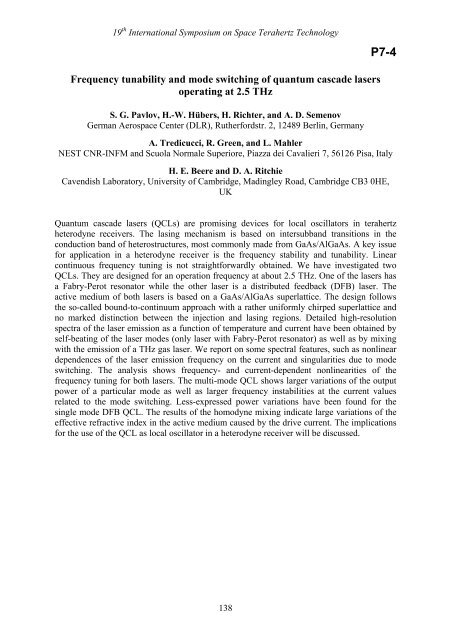Program and Abstract Book - SRON
Program and Abstract Book - SRON
Program and Abstract Book - SRON
Create successful ePaper yourself
Turn your PDF publications into a flip-book with our unique Google optimized e-Paper software.
19 th International Symposium on Space Terahertz Technology<br />
P7-4<br />
Frequency tunability <strong>and</strong> mode switching of quantum cascade lasers<br />
operating at 2.5 THz<br />
S. G. Pavlov, H.-W. Hübers, H. Richter, <strong>and</strong> A. D. Semenov<br />
German Aerospace Center (DLR), Rutherfordstr. 2, 12489 Berlin, Germany<br />
A. Tredicucci, R. Green, <strong>and</strong> L. Mahler<br />
NEST CNR-INFM <strong>and</strong> Scuola Normale Superiore, Piazza dei Cavalieri 7, 56126 Pisa, Italy<br />
H. E. Beere <strong>and</strong> D. A. Ritchie<br />
Cavendish Laboratory, University of Cambridge, Madingley Road, Cambridge CB3 0HE,<br />
UK<br />
Quantum cascade lasers (QCLs) are promising devices for local oscillators in terahertz<br />
heterodyne receivers. The lasing mechanism is based on intersubb<strong>and</strong> transitions in the<br />
conduction b<strong>and</strong> of heterostructures, most commonly made from GaAs/AlGaAs. A key issue<br />
for application in a heterodyne receiver is the frequency stability <strong>and</strong> tunability. Linear<br />
continuous frequency tuning is not straightforwardly obtained. We have investigated two<br />
QCLs. They are designed for an operation frequency at about 2.5 THz. One of the lasers has<br />
a Fabry-Perot resonator while the other laser is a distributed feedback (DFB) laser. The<br />
active medium of both lasers is based on a GaAs/AlGaAs superlattice. The design follows<br />
the so-called bound-to-continuum approach with a rather uniformly chirped superlattice <strong>and</strong><br />
no marked distinction between the injection <strong>and</strong> lasing regions. Detailed high-resolution<br />
spectra of the laser emission as a function of temperature <strong>and</strong> current have been obtained by<br />
self-beating of the laser modes (only laser with Fabry-Perot resonator) as well as by mixing<br />
with the emission of a THz gas laser. We report on some spectral features, such as nonlinear<br />
dependences of the laser emission frequency on the current <strong>and</strong> singularities due to mode<br />
switching. The analysis shows frequency- <strong>and</strong> current-dependent nonlinearities of the<br />
frequency tuning for both lasers. The multi-mode QCL shows larger variations of the output<br />
power of a particular mode as well as larger frequency instabilities at the current values<br />
related to the mode switching. Less-expressed power variations have been found for the<br />
single mode DFB QCL. The results of the homodyne mixing indicate large variations of the<br />
effective refractive index in the active medium caused by the drive current. The implications<br />
for the use of the QCL as local oscillator in a heterodyne receiver will be discussed.<br />
138
















